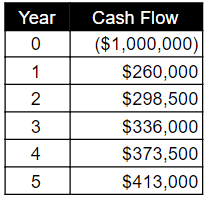Prior to deploying funds into a commercial real estate investment opportunity, it is absolutely critical to perform a significant amount of due diligence on the target property. This due diligence includes a review of the physical aspects of the property like its condition, location, and a review of the financial aspects of the property like its income statement, balance sheet, and market comparables.
As part of the financial review and underwriting process, the analyst or investor will create a Proforma and use it to calculate a number of key financial metrics to assess potential investment returns. One of these metrics, the Equity Multiple, is an important data point to consider when making an investment decision in a potential real estate deal.
What is a Proforma?
In order to understand how the Equity Multiple is calculated and its role in commercial real estate investing, it is first necessary to understand what goes into creating the proforma.
A proforma is a forward-looking financial projection of the target property’s operational performance. It includes income, which is derived from tenant rental payments, and expenses, which are incurred in the course of operating the property. Using past performance and market dynamics as a guide, income and expenses are projected for a planned holding period, usually 5-10 years, and the end result could look something like the following table (for a multifamily property in New York):

When attempting to calculate investment return metrics, the key line in the proforma is the last one, Cash Available for Distribution. This represents the amount of money that is left over after all expenses have been paid, including the loan payment, and these are the funds that are available to be distributed to investors in the property.
How the Equity Multiple Works
The Equity Multiple represents an investor’s absolute return, relative to their initial investment. Once the proforma has been created, the equity multiple formula is: Total Cash Received / Total Equity Invested (including Preferred Equity). Using the example above and assuming the initial investment is $1,000,000, the proforma cash flows can be rearranged into the following table:

With this set of cash flows, the Equity Multiple is calculated as:

The resulting Equity Multiple of 1.68 means that, by the end of the investment holding period, the investor has received 1.68x their original investment. While this may seem like a good return ,it lacks context, which is one of the reasons why the Equity Multiple should not be used in isolation when evaluating the return potential of a property.
Equity Multiple Drawbacks
The primary drawback to using the Equity Multiple as a method for measuring returns is that there is no reference to the amount of time that it takes to achieve it. In the example above, the time period used was 5 years, but if the same set of cash flows was stretched to 10 years or 15 years, the Equity Multiple would still be the exact same.
For this reason, the Equity Multiple is often used in conjunction with another metric, the Internal Rate of Return, to evaluate the potential success of investment. The combination of these metrics is particularly useful when comparing potential returns between two properties.
The Internal Rate of Return is defined as the discount rate that sets the net present value of all future cash flows equal to zero. It is complementary to the Equity Multiple because it accounts for the “time value of money,” which is the concept that a dollar earned today is worth more than a dollar earned in the future due to its ability to be reinvested and earn interest. IRR is often used as a proxy for the compound annual rate of return on a series of cash flows and it can be easily calculated using the “IRR” function in a spreadsheet. To illustrate how it works – and its relationship to the Equity Multiple – consider the example of the following two properties:

With this set of cash flows, the Equity Multiple is 1.85Xfor Property #1 and 1.90X for Property #2. In addition, Property #1 has an Internal Rate of Return of 19.71% while Property #2 has lower IRR of 16.37%. These metrics perfectly illustrate why it is important to look at both of them when evaluating an investment. The IRR for Property #1 is higher so it may be easier to automatically assume that it is the better investment. But, the Equity Multiple for #2 is higher, so maybe that one is the better option?
In reality, Property #2 offers a better return – even if the IRR is lower – because it has the higher Equity Multiple over the same time period. So, Equity Multiple is an important metric when measuring potential returns on an investment, but it should not be used in isolation because it lacks the context of how long it took to earn it. For this piece of the equation, it is best to use the Internal Rate of Return.
Interested In Learning More?
First National Realty Partners is one of the country’s leading private equity commercial real estate investment and asset management firms. With an intentional focus on finding world-class, multi-tenanted assets well below intrinsic value, we seek to create superior long-term, risk-adjusted returns for our investors while creating strong economic assets for the communities we invest in.
When evaluating our own deals, we use IRR, Equity Multiple, and a variety of other metrics to determine the most profitable deals for our investors. If you are an accredited investor and would like to learn more about our investment opportunities, contact us at (800) 605-4966 or info@fnrealtypartners.com for more information.




